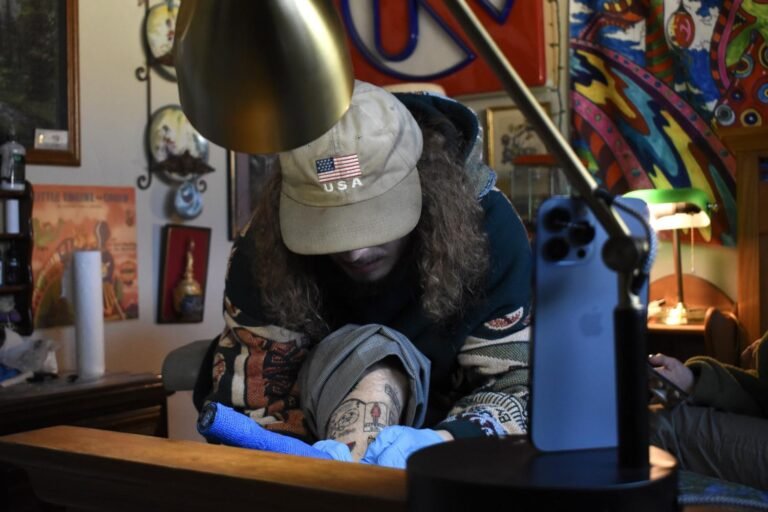Scars: Amazing Ways to Cover Up a Scar with a Tattoo!

Introduction
Scar camouflage tattoos are a remarkable way to effectively conceal scars using the artistry of ink. Through tattooing, these specialized artists can create designs that blend seamlessly with your skin, making the scars nearly invisible.
This article will delve into the world of scar cover-up tattoos, exploring:
- The different types of scars that can be successfully tattooed over
- Important considerations for getting a scar camouflage tattoo
- Alternative options for scar concealment
By the end of this article, you’ll have a comprehensive understanding of how tattoos can be an amazing solution for embracing your skin’s story.
Understanding Scar Camouflage Tattoos
Scar camouflage tattoos are a remarkable way to conceal scars with the artistry of tattooing. Here’s how they work:
How Scar Camouflage Tattoos Work:
Scar camouflage tattoos involve using specialized tattooing techniques and pigments to make scars less noticeable. By strategically tattooing over the scar tissue, skilled artists can blend the colors and textures, effectively camouflaging the scar. This process requires a deep understanding of skin tones, scar tissue characteristics, and artistic techniques to create a seamless integration with the surrounding skin.
Advantages of Choosing Scar Camouflage Tattoos Over Other Methods:
- Long-lasting results: Unlike temporary concealment methods, scar camouflage tattoos offer a permanent solution for concealing scars.
- Non-invasiveness: Unlike surgical procedures, these tattoos do not require invasive treatments or incisions, making them a safer option for scar coverage.
- Ability to match skin tones: Tattoo artists can customize the ink to match the client’s skin tone, ensuring a seamless blend with the surrounding tissue. This personalized approach results in remarkably natural-looking coverage that renders the scar nearly invisible.
Scar camouflage tattoos provide an effective and aesthetically pleasing solution for concealing scars, offering numerous advantages over alternative methods.
Types of Scars That Can Be Covered with Tattoos
When it comes to scar cover-up tattoos, there is a wide range of scars that can be effectively concealed through this artistic approach. From common surgical and accident scars to specific types like hair transplant and C-section scars, the potential of tattoos in concealing different kinds of skin irregularities is remarkable.
Some of the common types of scars that can be effectively covered with tattoos include:
- Surgical Scars: These are the result of surgical procedures and can vary in size and appearance.
- Burn Scars: Scars left behind by burns can often be challenging to conceal, but tattoo cover-ups offer a creative solution.
- Accident-Related Scars: Scarring from accidents, such as cuts and abrasions, can be effectively camouflaged with the right tattoo design.
- Hair Transplant Scars: Scars from hair transplant procedures on the scalp can be effectively hidden with specialized tattoo techniques.
- Stretch Marks: While not technically scars, stretch marks can also be minimized with tattoo cover-ups, providing a significant confidence boost.
- Facial Scars: Whether from acne, injuries, or surgeries, facial scars can be emotionally distressing for many individuals. Tattoo cover-ups offer a way to regain confidence and self-esteem.
- Tummy Tuck Scars: After undergoing tummy tuck surgery, individuals may opt for tattoo cover-ups to conceal resulting scars.
- C-Section Scars: The scar left behind after a cesarean section can also be effectively concealed with skillful tattooing.
- Self-Harm Scarring: Tattoos have been used to help individuals reclaim control over their bodies by covering self-harm scars with beautiful designs.
Before-and-after examples and success stories serve as powerful testaments to the effectiveness of scar cover-up tattoos for each type of scar discussed. These real-life accounts showcase the transformative impact that skilled tattoo artists can have in helping individuals embrace their skin’s story through artistry and creativity.
Factors to Consider for Effective Results
When deciding on a scar camouflage tattoo, it’s important to examine the characteristics of your scar tissue to ensure the best possible outcome. The texture and color of the scar are key factors in determining how successful the tattoo camouflage process will be.
Assessing Scar Tissue Texture
- The texture of the scar is an important factor to consider before getting a tattoo. Raised or uneven textures may affect how the ink settles and appears on the skin.
- Scars with smooth textures tend to achieve better results with tattoo camouflage, as the ink can blend more seamlessly with the surrounding skin. Understanding different scar revision techniques available may help improve texture prior to tattooing.
Evaluating Scar Coloration
- The color of the scar compared to your natural skin tone is another critical consideration.
- Darker or lighter scars may require specific pigment-matching techniques to achieve a natural blend.
- Understanding how different pigments interact with the scar tissue is essential for creating a harmonious and realistic appearance.
By carefully evaluating these factors, you can work with a skilled tattoo artist to develop a customized approach that addresses the unique characteristics of your scar tissue. This assessment, along with exploring scar revision methods, will ultimately contribute to achieving effective and aesthetically pleasing results with your scar camouflage tattoo.
Scars That May Not Be Suitable for Tattoo Cover-ups
When considering scar camouflage tattoos, it’s important to be aware of the limitations and potential risks associated with tattooing over certain types of scars. While scar cover-up tattoos can be incredibly effective in concealing various types of scars, there are instances where this technique may not yield the desired results. Here are some factors to consider:
1. Hypertrophic Scars and Keloid Scars
Hypertrophic scars are raised and thickened scars that often result from trauma or surgery. Keloid scars, on the other hand, are characterized by excessive scar tissue growth beyond the boundaries of the original injury. Both hypertrophic and keloid scars have a tendency to continue growing even after the wound has healed.
Due to their unique characteristics, these types of scars may not respond well to tattooing. The tattoo ink may not blend seamlessly with the raised texture of hypertrophic or keloid scars, potentially resulting in an uneven appearance.
2. Scars with Significantly Different Coloration
Scar camouflage tattoos work by using pigments that closely match the surrounding skin tone to create a seamless blend. However, if a scar is significantly darker or lighter than the surrounding skin, achieving a natural-looking result through tattooing alone might be challenging.
In such cases, alternative treatments or concealment options may be more suitable.
3. Fresh or Healing Scars
It’s essential to allow scars ample time to heal before considering a scar camouflage tattoo. Freshly healed scars need time to settle and mature to ensure stable results from tattooing.
Tattooing over scars that are still healing can potentially disrupt the healing process and lead to complications.
4. Certain Skin Conditions
Skin conditions such as psoriasis or eczema can affect how a scar responds to tattooing. These conditions can cause inflammation, redness, or flaking of the skin, which may impact the outcome and longevity of a scar camouflage tattoo.
It’s crucial to consult with a dermatologist or tattoo artist experienced in working with scarred skin and specific skin conditions to determine the best course of action.
Alternative Treatments and Concealment Options
In cases where scar camouflage tattoos may not be suitable, there are alternative treatments and concealment options to explore:
- Medical Treatments: Depending on the type and severity of the scar, medical treatments such as laser therapy, dermabrasion, or steroid injections may help reduce the appearance of scars. These treatments aim to improve the texture, color, and overall visibility of scars without the need for tattooing.
- Skin Adhesives: For scars that cannot be effectively covered with tattoos, various types of skin adhesives or silicone sheets can help minimize their appearance. These products work by providing a protective barrier while promoting optimal healing and reducing scar visibility.
It’s important to consult with a dermatologist or healthcare professional to determine the most suitable treatment option based on individual circumstances. They can provide expert guidance and recommend the best course of action for each unique situation.
Remember, every scar is different, and what works for one person may not work for another. The key is to explore different options and find the approach that best suits your specific needs and preferences.
Exploring Inkless Scar Serum Treatments as an Alternative Approach
If you’re seeking a non-tattooing option to minimize the appearance of scars, inkless scar serum treatments can be a viable alternative. These treatments focus on reducing the visibility of scars without the use of pigments. Instead, they utilize specialized serums and creams that target scar tissue to promote healing and improve the overall appearance.
Inkless scar serum treatments work by targeting the underlying causes of scar formation, such as inflammation and collagen overproduction. The serums often contain ingredients like retinol, hyaluronic acid, vitamin C, and peptides, which have been shown to have beneficial effects on scar tissue. By applying these serums regularly, you can help soften the scar tissue, reduce redness and discoloration, and improve the texture of the skin.
Pros and Cons Compared to Scar Camouflage Tattoos
Pros:
- Non-invasive: Unlike tattoos, inkless scar serum treatments do not involve any needles or puncturing of the skin. This makes them a more suitable option for those who may be hesitant about tattooing.
- Temporary: If you’re unsure about making a permanent change to your skin or if you want to try out different options before committing to a tattoo, inkless scar serum treatments provide a temporary solution.
- Can be used on various scar types: Inkless scar serum treatments can be used on different types of scars, including surgical scars, acne scars, and stretch marks. They offer versatility in addressing various forms of scarring.
- Effective for lupus-related skin damage: For individuals with skin damage caused by conditions like lupus, inkless scar serum treatments can be particularly beneficial. These treatments can help repair and improve the appearance of the damaged skin.
Cons:
- Limited effectiveness for severe scars: While inkless scar serum treatments can help improve the appearance of mild to moderate scars, they may not provide significant results for more severe or deeply indented scars.
- Requires consistent application: To see noticeable improvements in your scars, it’s essential to apply the serum regularly and follow the recommended usage instructions. This can require patience and dedication over an extended period.
- Results may vary: The effectiveness of inkless scar serum treatments can vary depending on factors such as scar type, age, and individual skin response. What works for one person may not work as well for another.
- Skin needling for stretch marks: For individuals specifically looking to address stretch marks, combining inkless scar serum treatments with skin needling techniques can yield more significant results.
It’s important to note that inkless scar serum treatments are not a quick fix and may require several weeks or months of consistent use before visible improvements are seen. They are best suited for individuals who prefer non-invasive options or have scars that are not suitable for tattoo cover-ups.
Finding a Professional Tattoo Artist Specialized in Scar Cover-ups
When it comes to getting a scar cover-up tattoo, finding the right tattoo artist is crucial for achieving the best results. Here are some key points to consider when searching for a professional tattoo artist specialized in scar cover-ups:
1. Research Methods
Start by researching tattoo artists who have experience and expertise in scar cover-up tattoos. Look for artists who specifically showcase scar cover-up work in their portfolios. You can utilize online platforms, social media, and tattoo forums to discover artists known for their skill in this specialized area.
2. Portfolio Assessment
Once you identify potential tattoo artists, carefully examine their portfolios. Look for before-and-after photos of scar cover-up tattoos they have done in the past. Pay attention to:
- The quality of the work
- The ability to match skin tones
- How effectively the scars are concealed
3. Client Reviews
Reading client reviews and testimonials can provide valuable insights into the experiences of individuals who have received scar cover-up tattoos from specific artists. Look for feedback related to:
- Scar coverage
- Overall satisfaction with the results
- The professionalism of the artist
When you have narrowed down your choices and are ready to schedule consultations with potential tattoo artists, here are some important questions to ask during these meetings:
- Can you show me examples of scar cover-up tattoos you have done?
- How do you approach matching skin tones to ensure seamless blending with surrounding tissue?
- What is your experience in working with different types of scars, including [specific type of scar]?
- Can you provide references or client testimonials related to scar cover-up work?
- What aftercare advice do you recommend specifically for scar cover-up tattoos?
Asking these questions will not only help you gauge the expertise of the tattoo artist but also establish a level of trust and confidence in their ability to effectively handle scar tissue and deliver satisfying results.
By taking the time to find a skilled and experienced tattoo artist specializing in scar cover-ups, you can set yourself up for a successful and transformative experience that leads to greater confidence in embracing your skin’s story through artistry.
Preparing Yourself and Your Scar for a Successful Camouflage Tattoo Session
Before your scar camouflage tattoo appointment, there are important steps to take to ensure a successful and satisfying experience.
1. Gathering Reference Images
Collect images of tattoo styles, designs, or motifs that resonate with you. These can serve as a visual reference for the tattoo artist, helping them understand your aesthetic preferences and desired outcome.
2. Skin Preparation
It’s crucial to ensure that your skin is in optimal condition for the tattooing process. This involves keeping the skin well-moisturized and avoiding any irritants or substances that could affect the tattoo application.
During the consultation with the tattoo artist, be prepared to engage in a collaborative process aimed at achieving the best possible results.
3. Thorough Consultation
The consultation with the artist is an opportunity to discuss your expectations, share your ideas for the design, and gain an understanding of the tattooing process specific to scar cover-ups. Be open to the artist’s suggestions and expertise, as they can provide valuable insights into what will work effectively for your scar.
4. Design Collaboration
Working closely with the artist on the design is essential. They may need to adapt certain elements of the design to suit the unique characteristics of your scar. This collaborative approach ensures that both you and the artist are aligned on the vision for the tattoo.
Aftercare practices following the scar camouflage tattoo session are vital for proper healing and long-term results.
5. Essential Aftercare Practices
The artist will provide detailed aftercare instructions tailored specifically to scar cover-up tattoos. Following these instructions diligently can significantly impact the healing process and overall longevity of the tattoo. This may include using specialized ointments, keeping the area clean, avoiding direct sunlight, and refraining from activities that could compromise the integrity of the tattoo during healing.
By preparing yourself and your scar adequately before, during, and after your scar camouflage tattoo session, you contribute to a positive outcome that allows you to embrace your transformed skin with confidence.
Embracing Your Transformed Skin Through Scar Camouflage Tattoos
Scar camouflage tattoos have the incredible power to not only conceal scars but also boost self-confidence and empower individuals to embrace their unique skin stories. By transforming scars into beautiful works of art, these tattoos allow individuals to reclaim control over their bodies and celebrate their journey towards acceptance.
The Empowering Role of Tattoos in Concealing Scars and Boosting Self-confidence
Scar cover-up tattoos are more than just a physical alteration; they provide emotional healing by helping individuals gain confidence in their appearance. By choosing to cover up their scars with tattoos, people can rewrite their narratives and create a new chapter that embraces self-acceptance and resilience.
The Process of Getting a Scar Camouflage Tattoo: Taking Ownership and Finding Strength
The process of getting a scar camouflage tattoo allows individuals to take ownership of their scars and view them as symbols of strength rather than imperfections.
Encouragement to Explore the Possibility of a Scar Cover-up Tattoo as a Creative and Personal Journey towards Acceptance
If you have been struggling with self-consciousness due to visible scars, consider exploring the option of scar camouflage tattoos as a creative solution. Here are some steps you can take:
- Consult with a skilled tattoo artist who specializes in scar cover-ups to discuss your unique needs, design ideas, and expectations.
- Remember that each scar tells a story, and by choosing to cover it up with a tattoo, you are creating a visual representation of your personal journey towards acceptance.
- Embrace the opportunity to transform your scars into something beautiful, turning what was once perceived as a flaw into a work of art that reflects your strength and resilience.
In conclusion, scar camouflage tattoos offer more than just physical concealment; they provide a pathway towards embracing one’s unique skin story. By choosing this creative solution, individuals can boost their self-confidence, rewrite their narratives, and embark on a personal journey towards acceptance.










